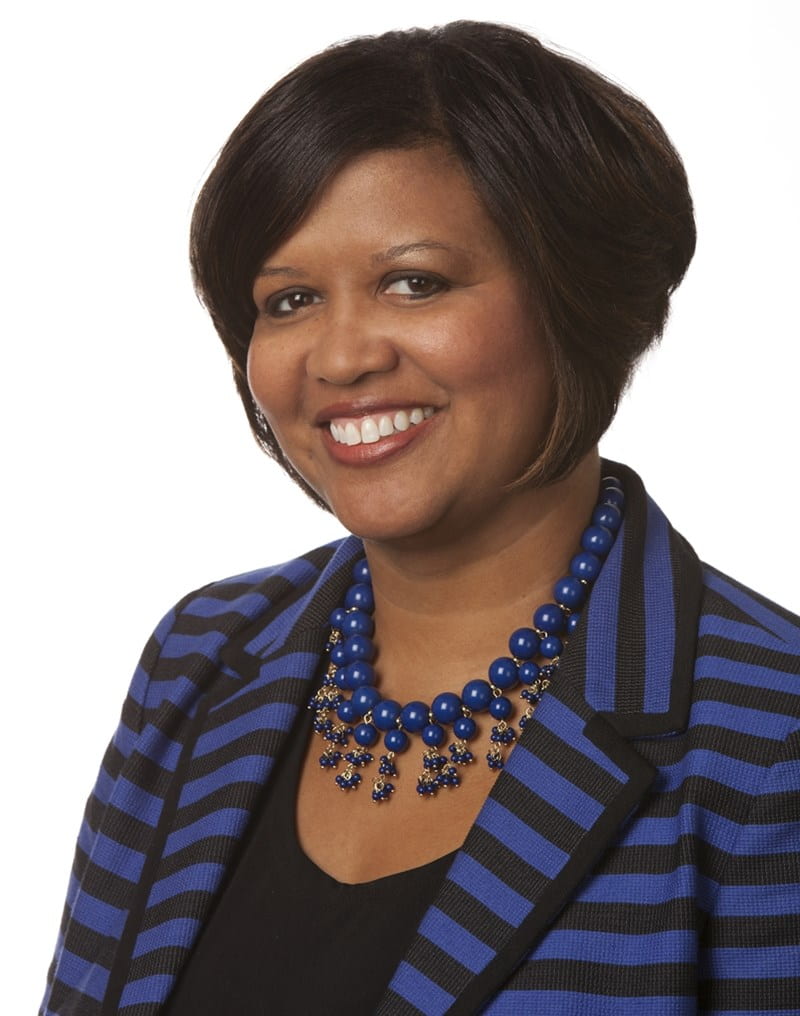 Tuesday September 17, 2019, Tia Brown McNair, the Vice President for Diversity, Equity and Student Success for Association of American Colleges and Universities (AAC&U) presented on Becoming a Student-Ready University. The mission of the AAC&U is to advance the vitality and public standing of liberal education by making quality and equity the foundations for excellence in undergraduate education in service to democracy.
Tuesday September 17, 2019, Tia Brown McNair, the Vice President for Diversity, Equity and Student Success for Association of American Colleges and Universities (AAC&U) presented on Becoming a Student-Ready University. The mission of the AAC&U is to advance the vitality and public standing of liberal education by making quality and equity the foundations for excellence in undergraduate education in service to democracy.
Her talk was based on her book Becoming a Student-Ready College: A New Culture of Leadership for Student Success.
Evidence Specific to our University
Trevor Francis, Associate Vice Provost and Director for Student Success, talked first about whether or not we have a lack of equity at our University. He showed graphs that very clearly indicate that there are issues with equity in the retention of various groups on campus. While student retention rates are at record highs, there remain areas where improvements can be made.
- Most at risk of dropping out are those freshmen who enter the university with relatively low high school GPAs. Of students with high school GPAs below 3.0, under 60% (59%) are retained to a second Fall semester and just one of five (21%) graduate within four years. Students with high school GPAs at or above 4.0 are many times more likely to graduate within four years (74% vs. 20%).
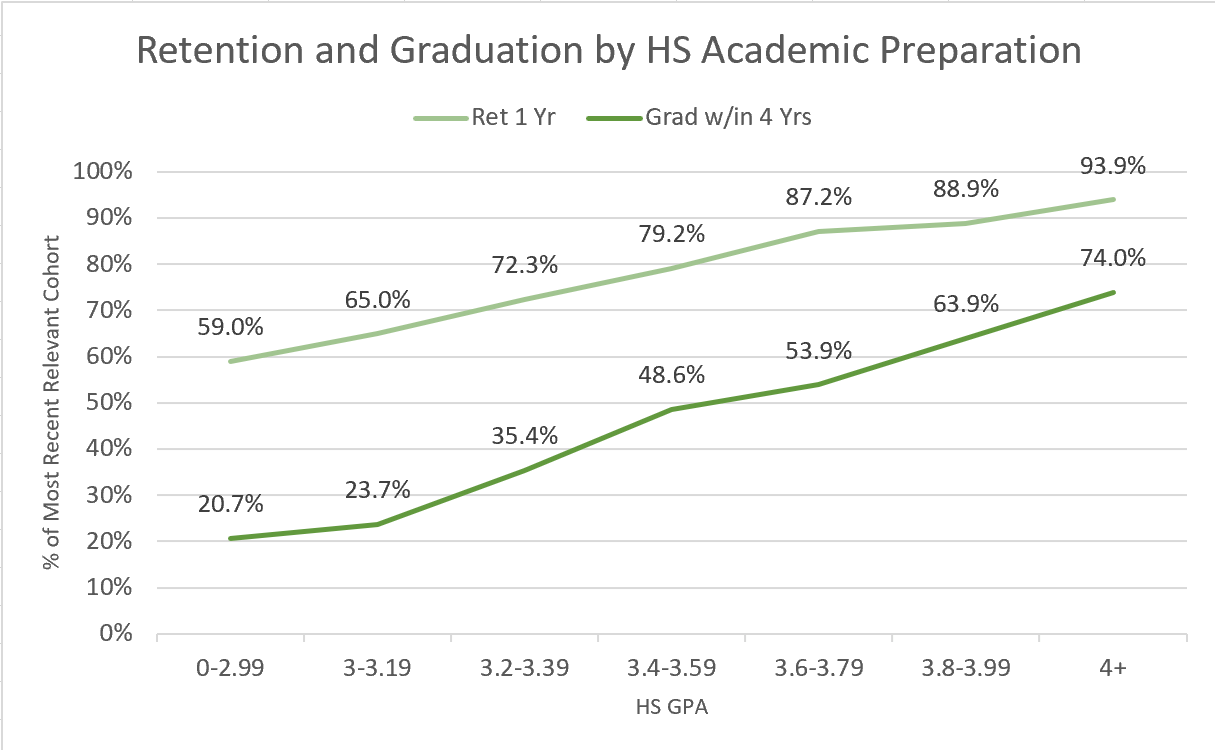
- For more than 20% of Arkansas residents, first-year cost of attendance exceeds estimated family contribution and free aid by $10,000 or more. Less than one out of three such residents graduate within four years. Residents with no unmet need are almost twice as likely to graduate within four years.
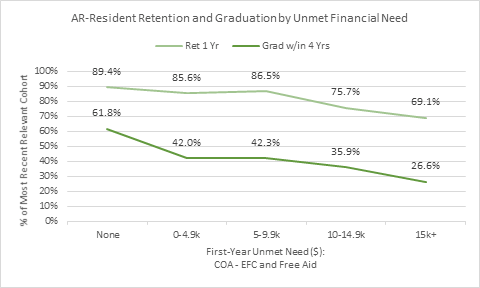
- Success rates remain relatively low too for students neither of whose parents completed a college degree. As compared to their counterparts one or more of whose parents completed a college degree, first-generation students have a freshman DFW rate 10 points higher (21% vs. 11%), a retention rate 13 points lower (74% vs. 87%), and a four-year graduation rate 20 points lower (36% vs. 56%). Similar differences obtain when adjusting for HS GPA.
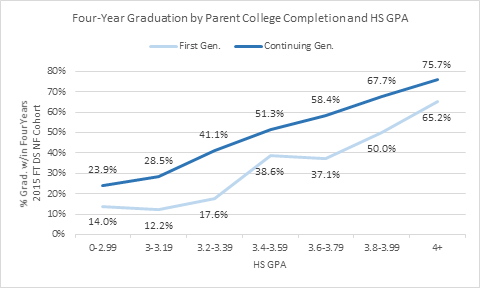
- Finally, success rates remain low for students who begin their careers living off campus. As compared to the majority of students who initially live on campus, off-campus students have a freshman DFW rate 10 points higher (22% vs. 12%), are retained one year at a rate more than 10 points lower (74% vs. 85%) and graduate within four years at a rate more than 20 points lower (33% vs. 54%). Differences in DFW, retention, and graduation rates by initial housing type remain substantial after adjusting for HS GPA.
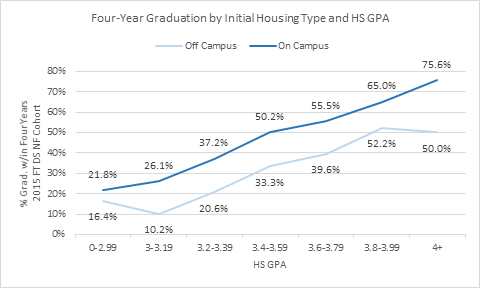
Charts and data summaries courtesy of the Office of Student Success.
For more detailed information see the following sites:
- UA’s Office of Institutional Research Retention and Graduation Rates
- UA’s Office of Institutional Research 2018-2019 Mini Fact Book
- UA Newswire, “U of A Moves Up in U.S. News…”
Adapting to Thrive
Dr. McNair started out with an activity. Everyone was paired up with a partner and asked to take turns counting up to 4. It became incrementally more difficult each round by adding a clap for one number and a snap for another. We talked then about the necessary adaptions that each person had to make. Some people couldn’t snap so they had to click with their tongue instead. Those types of adaptations are similar to the ways someone must change to counteract the deficiencies in advantage that they might experience for any number of reasons.
But why am I doing this?
We then discussed that knowing the reasoning behind what we are doing might have made the activity more worthwhile to us in the moment just as explaining to the students the reason behind the activity and subject matter can make them more connected to the subject matter and activity. Knowing relevancy increases engagement. A student who has no idea why they are being taught something has a much more difficult time connecting it to their long term goals and career.
So What Can We Do?
The highest factor for student success is a caring mentor. We need a deeply human touch. Basically, we need everyone to care about our students’ well being and success, but how do we make people care?
Dr. Brown McNair talked about the kinds of committee meetings that we have. Important people behind closed doors deciding the fate of the university and its programs, but the people with the titles aren’t the ones that have the most interaction with and effect on the students. It’s the front line people who make all the difference. She talked about a student who when asked about the person who was most crucial to her success did not name an administrator or a faculty member, but the overnight custodian at the library who would check in on her at night when she was studying. These are the people who have to be brought to the table for committee meetings.
She described a way of doing things that allowed everyone to be brought to the table. A large room where multiple committees are meeting at once and everyone is invited to take part. After the meetings are complete, all of the other committees can go around and see the notes posted on the walls and give their feedback for those as well. In this way we get feedback from all levels, and we make our staff, faculty, and administrators better understand the role they play in our students’ academic careers and lives.
Understanding the Barriers and Knowing the Resources
Dr. Brown McNair explained that we must first know our students’ barriers and then do what we can to eliminate them. One example that came up was hunger. 38% of our students will experience food insecurity during their career at the U of A. Assistance with overcoming this barrier can be found with the Jane B. Gearhart Full Circle Food Pantry, but first we have to make sure everyone knows about these services. Lack of institutional-wide awareness of services is something that could be improved to help support the entire campus community.
One of the suggestions that came up to alleviate this lack of awareness is a fair for information about student services that is aimed specifically at the instructors. Another idea that the TIPS team will be pursuing is spotlighting services that might help our students on the TIPS Facebook and Twitter accounts.
Building Our Values into Our Processes
If we care about the students and want to make this a student-ready university, then we have to build the values into the ways that our faculty are rewarded and evaluated. Promotion and Tenure has to include metrics for mentoring students and trying out new teaching methods that may help students who are struggling with the historically popular ways of teaching.
Further Resources
This content was developed from a presentation by Dr. Tia Brown McNair which was sponsored in part by the Teaching and Faculty Support Center, the Office of Diversity and Inclusion, the Dean of Students, the Multicultural Center, the Office of Student Success, and the J. William Fulbright College of Arts and Sciences.
A copy of the presentation for this event can be found on the HIPS.uark.edu site.